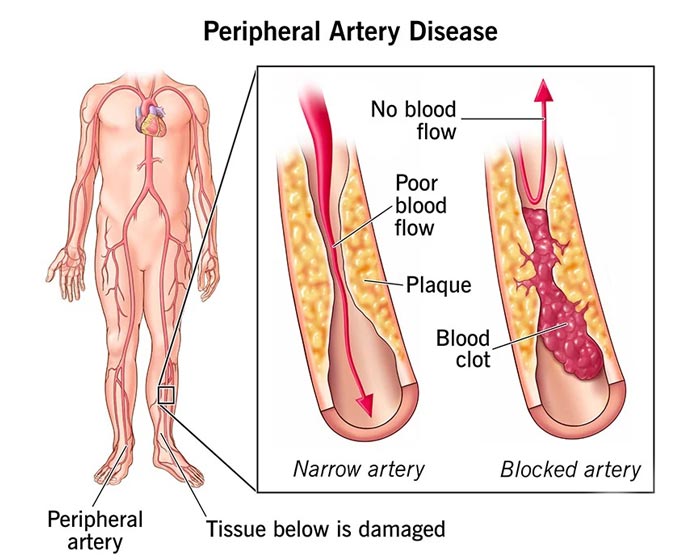
1. Introduction
Peripheral Artery Disease (PAD) is a condition where the arteries in your legs become narrowed or blocked, often leading to pain and difficulty walking. It is a common yet serious health issue, especially in older adults. PAD can also increase the risk of heart attacks and strokes. Understanding who is most likely to develop PAD can help with early detection and prevention. In this blog, we’ll explore the key factors that contribute to the development of PAD and the groups most at risk. If you’re concerned about PAD, a peripheral artery disease specialist can help guide you in managing the condition.
2. What is Peripheral Artery Disease?
Peripheral Artery Disease (PAD) occurs when the blood vessels that carry blood to your limbs become narrowed or blocked, reducing blood flow to your legs and feet. This is usually caused by a build-up of fatty deposits or plaque in the arteries, known as atherosclerosis. People with PAD may experience pain, cramping, or weakness in their legs, particularly when walking or exercising. In severe cases, PAD can lead to complications like gangrene or even require amputation. PAD can also increase the risk of heart attack and stroke because it often reflects broader cardiovascular issues. Early diagnosis is key, and a peripheral artery disease specialist can help with the right treatments and lifestyle changes. If you live in or near Vasai, visiting the Best diagnostic center in Vasai can offer advanced tests to detect PAD early, providing peace of mind and a treatment plan tailored to your needs.
3. Why is Peripheral Artery Disease a Concern?
Peripheral Artery Disease is a serious concern because it affects blood flow to your limbs, causing pain and discomfort, and making it difficult to walk in some cases. PAD can also indicate poor circulation, which reflects broader artery damage throughout the body. This condition can lead to complications such as infections, ulcers, or tissue death, which might require amputations if untreated. For those with PAD, it significantly increases the risk of heart attacks, strokes, and other cardiovascular diseases. If you experience any symptoms, it’s essential to visit a peripheral artery disease specialist for proper diagnosis and guidance. Early intervention can reduce risks and improve overall quality of life. If you’re unsure where to get checked, visiting a x-ray clinic or a x-ray center can help identify underlying issues with your arteries and offer crucial insights to your healthcare provider.
4. Who is Most Likely to Develop Peripheral Artery Disease?
Certain groups of people are more likely to develop Peripheral Artery Disease (PAD). The biggest risk factors include age, with PAD being more common in individuals over 50. Smoking is another significant risk factor, as it can contribute to the narrowing of arteries, while diabetes affects blood sugar levels and damages blood vessels over time. Other risk factors include high cholesterol, high blood pressure, and a family history of cardiovascular diseases. Being overweight, physically inactive, or having a poor diet can also increase the chances of developing PAD. If you have one or more of these risk factors, it’s a good idea to visit a peripheral artery disease specialist who can help you understand your risk and suggest preventive measures. For those living in Vasai, it’s worth considering the Best diagnostic center in Vasai for a thorough check-up and accurate diagnosis of PAD.
5. What Are the Symptoms of Peripheral Artery Disease?
The symptoms of Peripheral Artery Disease (PAD) can vary, but common signs include pain or cramping in the legs when walking, called claudication. You may also experience weakness, fatigue, or numbness in your legs. Slow-healing wounds, cold feet, or changes in skin color on your legs are also signs of PAD. If these symptoms sound familiar, it’s important to visit a peripheral artery disease specialist for a diagnosis. Early treatment can prevent further complications and improve your mobility. Local x-ray clinics or x-ray centers may help diagnose PAD through various imaging tests to assess blood flow and identify blockages.
6. How is Peripheral Artery Disease Diagnosed?
To diagnose Peripheral Artery Disease, healthcare providers typically perform a physical exam, review your medical history, and may conduct several tests. One common test is the ankle-brachial index (ABI), which compares blood pressure in the arms and legs. Ultrasound or angiography can also be used to visualize the arteries. If you’re concerned about PAD, visiting a x-ray clinic or x-ray center in your area can be the first step in identifying potential problems with your circulation.
7. Conclusion
Peripheral Artery Disease is a serious condition that requires early detection and treatment. Those at higher risk, such as older adults, smokers, and individuals with diabetes, should be particularly vigilant. If you suspect you might have PAD, it’s important to seek help from a peripheral artery disease specialist who can guide you in managing the condition. Whether you’re located in Vasai or elsewhere, getting checked at the Best diagnostic center in Vasai is a great way to ensure your vascular health is properly monitored. Early intervention can make all the difference!

